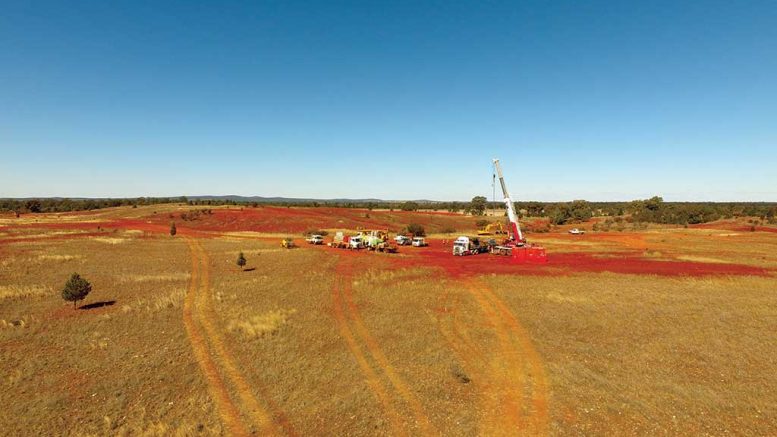Just a little over a month after it signed an offtake agreement with one of the world’s largest producers of cathode material for the lithium-ion battery industry, Clean TeQ Holdings (AS: CLQ) has announced an increase in cobalt ore grade and contained metal at its newly renamed Sunrise cobalt-nickel-scandium project (formerly named Syerston) in Australia, 350 km west of Sydney.
A newly updated resource estimate tallies a 30% increase in cobalt grade and a 16% increase in contained cobalt metal compared to a resource estimate completed in August 2016.
The increase in grade should translate into a 30% jump in average cobalt production over the first 10 years of the project’s proposed mine life to 5,000 tonnes a year, and brings the company another step closer to its goal of becoming one of the largest global suppliers of cobalt and nickel sulphate to the lithium-ion battery for use in the electric vehicle market.
Sunrise’s measured and indicated resources using a 0.06% cobalt cut-off grade now stand at 87 million tonnes averaging 0.13% cobalt and 0.64% nickel for 116,000 tonnes cobalt metal and 558,000 tonnes nickel. The previous measured and indicated resources were based on a 0.60% nickel-equivalent cut-off grade and tallied 101 million tonnes grading 0.10% cobalt and 0.65% nickel for 106,000 tonnes cobalt and 660,000 tonnes nickel.
In the inferred category, the new resource measures 14 million tonnes grading 0.11% cobalt and 0.24% nickel, for 16,000 tonnes cobalt and 35,000 tonnes nickel. This compares with the 2016 inferred resource estimate of 8 million tonnes grading 0.10% cobalt and 0.54% nickel for 8,000 tonnes cobalt and 50,000 tonnes nickel.
Sam Riggall, Clean TeQ’s managing director, notes in a press release that previous studies had focused almost exclusively on nickel, “with little appreciation of the value represented by the inherent variability of cobalt grades.
“By focusing on a cobalt cut-off grade,” he says, the resource update “has led to the inclusion of higher-grade blocks that had previously been excluded from the geological model. It has also allowed for more selective rejection of low-grade and waste material.”
Sunrise is “unique” in its high cobalt content relative to nickel content, the company says. The deposit’s cobalt-nickel ratio in the updated resource is now 0.22 tonne cobalt to 1 tonne nickel, more than double its closest peer in Australia, Australia Mines’ (ASX: AUZ) Sconi cobalt-nickel-scandium project in Queensland. (Both are Australian laterite projects.)
Clean TeQ notes that due to the increase in anticipated cobalt production compared to last year’s prefeasibility study, the definitive feasibility study will need to reassess the impact on the design and cost of the resin-in-pulp adsorption-desorption and refinery circuits of the process flow sheet.
The new resource estimate gives Clean TeQ flexibility to respond to market conditions and manage production volumes of the cobalt, nickel and scandium metal contained in the deposit, Riggall adds.
The feasibility study will incorporate scandium oxide by-product recovery from the cobalt-nickel circuit with a nameplate capacity of 80 tonnes per year of scandium oxide. The company also has an option to increase production up to 170 tonnes a year if it installs a dedicated scandium recovery resin-in-pulp circuit as part of the flow sheet.
Scandium oxide can be used to make lighter and stronger aluminum alloys for the aerospace and automotive industries, as well as in the emerging field of 3-D printing.
The new resource puts Sunrise’s total scandium resource (measured, indicated and inferred) at 45.7 million tonnes grading 420 grams scandium per tonne for 19,200 tonnes contained scandium metal (a 63% increase in contained scandium metal). The estimate used a 300 gram cut-off grade, and of the total resource, 27% is in the measured and indicated category. The newest resource compares with 28.2 million tonnes of 419 grams scandium for 11,800 contained tonnes at the same cut-off grade.
The study will also examine options for low-cost platinum recovery via a separate beneficiation circuit. The new resource has increased the platinum resource to 103 million tonnes grading 0.33 gram platinum per tonne for 1.08 million contained oz. platinum, using a 0.15 gram per tonne cut-off grade. (Of this total resource, 94% of the metal content is in the measured and indicated category.) This compares to 109 million tonnes of 0.20 gram platinum for 700,800 contained oz. platinum in the earlier estimate.
Clean TeQ thinks it can complete the study in the first quarter of 2018.
Regulators have already approved the project’s environmental impact statement, and the company has received consent for a 2.5-million-tonne-per-year mining and processing operation.
Clean TeQ’s offtake agreement was signed with Beijing Easpring in August. Easpring produces nickel-cobalt-manganese and lithium cobalt oxide cathode chemistries, and its clients include major lithium-ion battery makers Sony, Samsung SDI and LG Chemical. The binding five-year purchase agreement will represent 20% of Sunrise’s annual cobalt and nickel-sulphate tonnage, and kicks in from the start of commercial production.
Sunrise, one of the largest and highest-grade undeveloped nickel and cobalt resources outside Africa, would be the first mine ever built dedicated to producing high-purity nickel and cobalt sulphate.
Cobalt is selling for US$26 per lb. and a recent research report from Macquarie Bank forecasts the price could rise to US$41 per lb. in 2022.
“By 2022 we see the [cobalt] market in a severe undersupply of more than 17,000 tonnes — equivalent to a copper deficit of 3 million tonnes, or an aluminium deficit of around 8 million tonnes.”
“The concentration of the supply side, with its 60% of mine output coming from the unpredictable Democratic Republic of the Congo, makes this metal an eye-catcher.”
Andrew Mikitchook of BMO Capital Markets raised his target price on Clean TeQ after the resource was released on Oct. 9 to A$1.75 per share, up A35¢.


Be the first to comment on "Clean TeQ boosts cobalt grade by 30% at Sunrise"